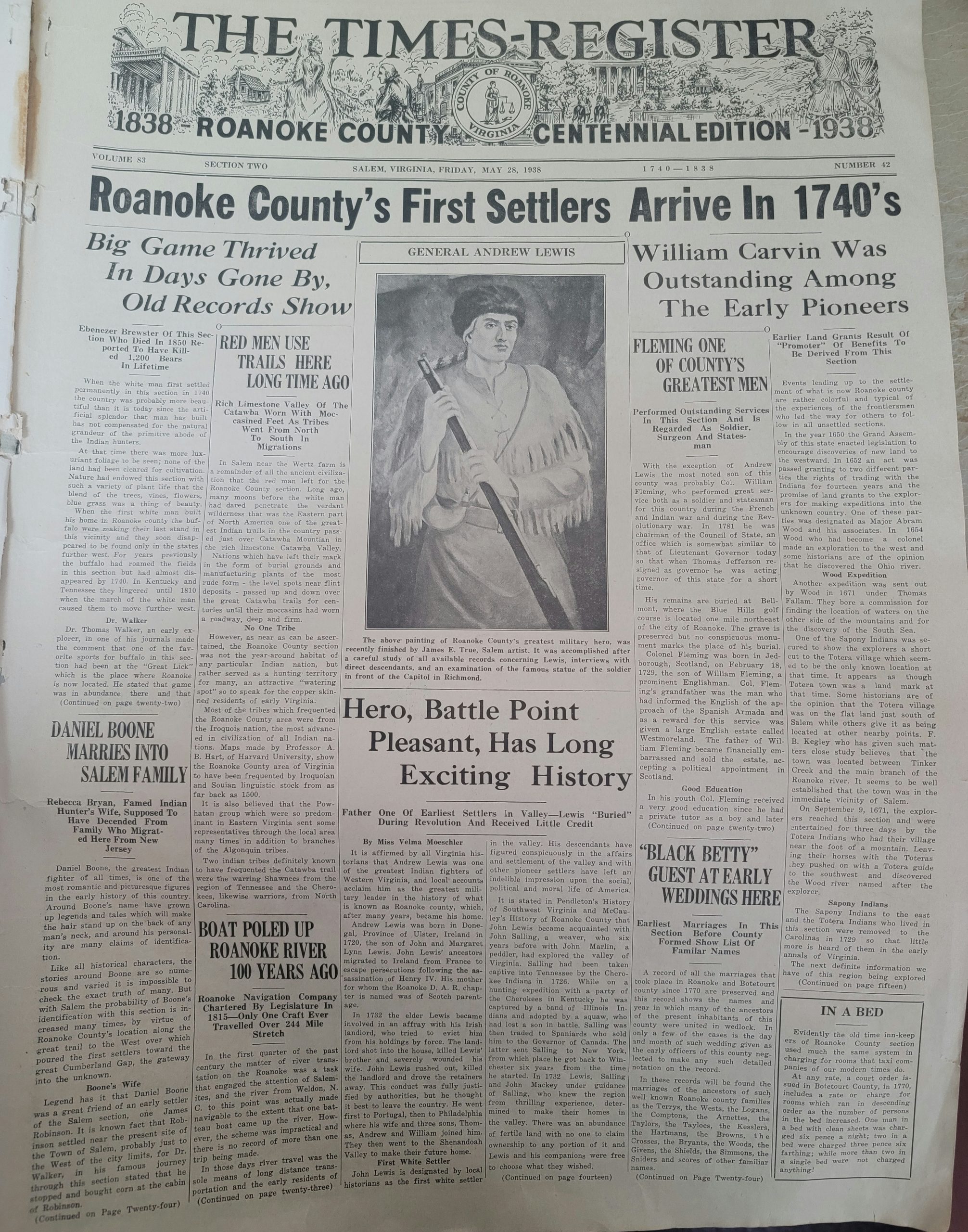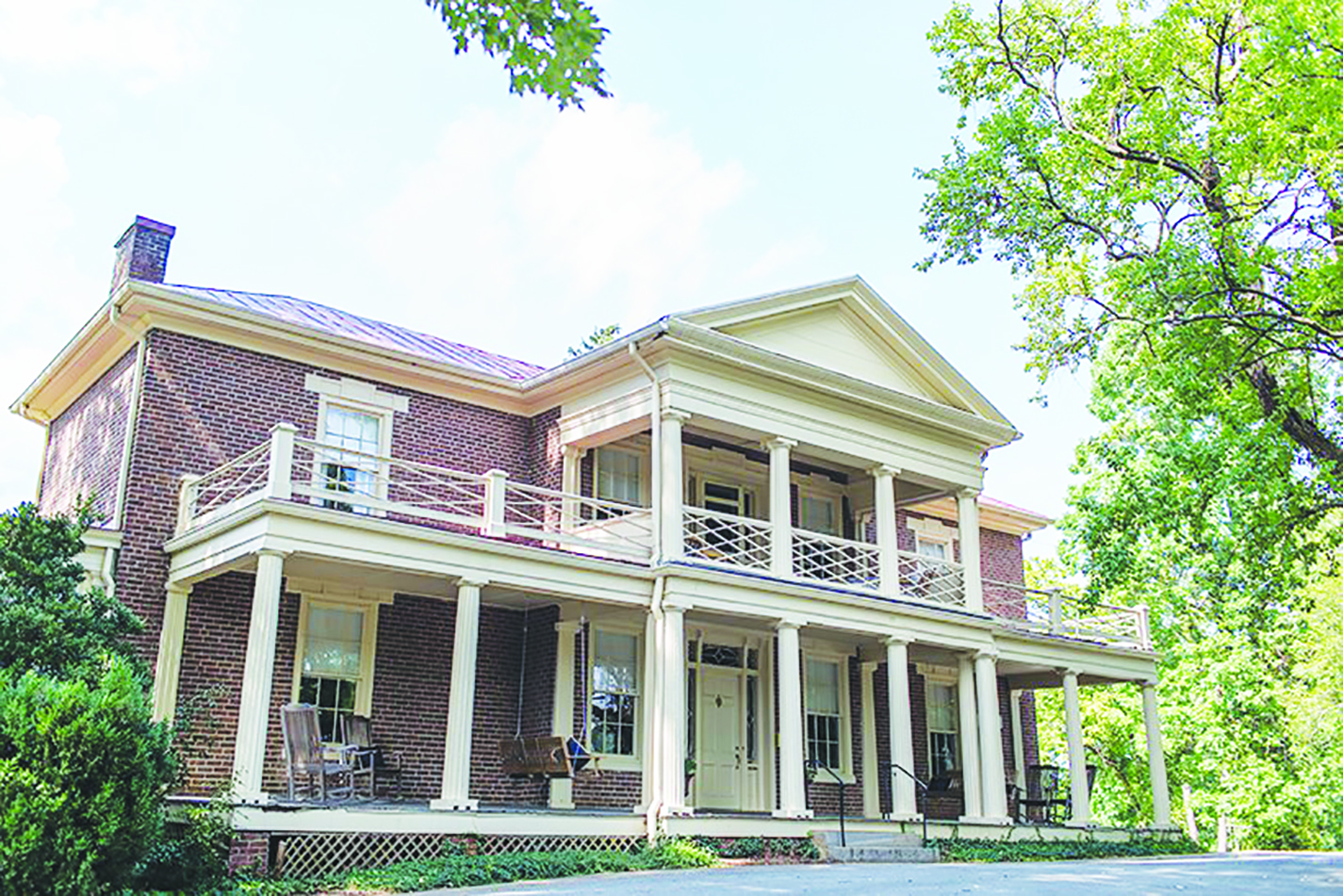
Earlier Land Grants Result Of “Promoter” Of Benefits To Be Derived From This Section
From the 1938 centennial edition of The Times-Register
Events leading up to the settlement of what is now Roanoke county are rather colorful and typical of the experiences of the frontiersmen who let the way for others to follow in all unsettled sections.
In the year 1650 the Grand Assembly of this state enacted legislation to encourage discoveries of new land to the westward. In 1652 an act was passed granting to two different parties the rights of trading with the Indians for fourteen years and the promise of land grants to the explorers for making expeditions into the unknown country. One of these parties was designated as Major Abram Wood and his associates. In 1654 Wood who had become a colonel made an exploration to the west and some historians are of the opinion that he discovered the Ohio river.
Wood Expedition
Another expedition was sent out by Wood in 1671 under Thomas Fallam. They bore a commission for finding the location of waters on the other side of the mountains and for the discovery of the South Sea.
One of the Sapony Indians was secured to show the explorers a short cut to the Totera village which seemed to be the only known location at that time. It appears as though Totera town was a landmark at that time. Some historians are of the opinion that the Totera village was on the flat land just south of Salem while others give it as being located at other nearby points. F. B. Kegley, who has given such matters a close study, believes that the town was located between Tinker Creek and the main branch of the Roanoke river. It seems to be well established that the town was in the immediate vicinity of Salem.
On September 9,1671, the explorers reached this section and were entertained by the Totera Indians who had their village near the foot of a mountain. Leaving their horses with the Toteras they pushed on with a Totera guide to the southwest and discovered the Wood river named after the explorer.
Sapony Indians
The Sapony Indians to the east and the Totera Indians who lived in this section were removed to the Carolinas in 1729 so that little more is heard of them in the early annals of Virginia.
The next definite information we have of this region being explored is through a journey made by John Marlin, a peddler, and John Salling, a weaver, two adventurous souls who set out from Winchester about 1726 to get first hand information concerning the great country beyond the early frontier.
While encamped at Big Lick they were surprised by a party of Cherokees and Salling was taken prisoner while Marlin escaped. For some years Salling remained with the Indians but during these years he was transferred from the Cherokees to the Illinois tribe who had captured him in Kentucky. Taken by the Illinois to Kaskaskia, Ill., he was adopted by an old squaw and treated as a son. After being with the Illinois for two years this squaw sold him to some Spaniards who were in need of an interpreter.
After many thrilling experiences which included one hunting trip as far south as the gulf of Mexico as a member of the Indian tribe, he was taken by the Spaniards to northern sections. A governor of Canada is said to have ransomed him and after six years spent in such unique surroundings he was permitted to return to Virginia.
Salling made his way to Williamsburg then to Winchester, where he met John Lewis and it was probably the tales Salling told of the lower Shenandoah valley that interested the father of Andrew Lewis in the vicinity. John Lewis settled near Staunton in 1732.
First Settler
Tradition has it that John Lewis was the first settler in the Roanoke valley and with that tradition little exception can be taken for the record is not complete. While it is entirely probable that John Lewis was accompanied by others who settled near Staunton at the same time it is well established that none settled in that vicinity before the father of Andrew Lewis.
On November 3, 1740 the state council granted to John Smith, Zachary Lewis, William Waller, and Robert Green and Benjamin Waller the right to enter and survey one hundred thousand acres of land on the branches of the Roanoke and James river. Small tracts of land were surveyed and John Smith acted as agent of the company, showing prospective purchasers over the land. The order of the council was renewed in 1745 but for smaller acreage. The first settlers in Roanoke county were probably induced to settle here by this company and it is taken for granted that some were here in 1742 but no grants were issued for land in this county until 1746.
By purchasing the interest of all the partners in this enterprise with the exception of Smith and Lewis, Colonel James Patton got the entire grant in his hands and up to the time of death Patton was instrumental in getting settlers to move into this vicinity. Patton was killed at Draper’s Meadow and Lewis assigned his interests in the land to his estate.
While Patton was the man behind the settlement project it seemed that John Smith was the only one active in the field. What methods were used to advertise their holdings is not known but they seemed to be effective.
Where John Smith lived is not known but he owned land about the Great Lick where Roanoke is now located and also owned some land at Looney’s Ferry. James Patton was born in Ireland in 1692 and for many years was master of a merchant ship that brought immigrants from Ireland to this country. He settled in Augusta county where he became quite prominent and held a number of offices. Besides holdings in this vicinity he got grants of land further west. He was killed by the Indians at Draper’s Meadow in 1755.
First Records
The first records we have of men who settled in Roanoke county or the land adjacent to it is from the records of the military company of George Robinson in 1742. George Robinson was the first settler at Greenfield where Colonel William Preston settled later. The men from this vicinity in Robinson’s company were Daniel Monahan, Mark Cole, Peter Renfoe, Henry Stiles, John Askins, James Cole, Bryan Cuff, Simon Acres, John Mason, William Akers, Tasker Tosh, Henry Brown, Samuel Brown, James Burke, Mark Evans, William Bean, Samuel Martin, Peter Kinder, Stephen Evans, Stephen Renfoe, William Bradshaw, John Cole, William Craven, Nicholas Horseford. Of this number it is probably that Tasker Tosh, James Burk, and Mark Evans were living within the bounds of what is now Roanoke county and that others had land within the county. The Coles had land adjoining George Robinson at Greenfield.
First Land Grant
The first grant of land to a known resident of this county was on July 25,1746 to William Carvin but it is known that Mark Evans was living near Big Lick in 1742 and that James Campbell settled at Fort Lewis in the same year. For some reason the land grants were delayed for some years after the settler had made his home.
From the first land grants we find that the Main body of the Roanoke in the upper region was known as Goose Creek, that the branch now known as Tinker Creek was called Buffalo Creek while the lower part of the Roanoke was known as Smith’s Creek. The south branch of the Roanoke was called the south fork as it is today.
In the surveyors book of 1748 of Augusta county reference is made to land being granted to Mark Evans estate, William Bryan, John Mills, William Carvin, Archibald Graem, William Sayers, Tasker Tosh and Thomas Tosh. The land conveyed to these men appears to have been in Roanoke county. The grant of land made to Thomas Tosh afterwards became the property of Andrew Lewis. Mark Evans was dead in 1748 and he left to his heirs quite a large tract of land near Big Lick.
Such was the beginning of the present county. During the Indian wars this county was the farthest frontier as the land further west was practically deserted when the Indians went on a rampage.
Original Census
The first census taken by the militia from 1782 to 1785 showed that Botetourt county had a population of a little more than 10,000 including slaves.
In those early days when this country was first settled land was to be had by merely settling on it. By building a cabin and raising a crop of grain, regardless of the acreage of the crop, entitled a man to 400 acres of land and a preemption right to another 1,000 acres which would be secured by a land office warrant.
Certificates of settlement rights were given by a commission of three men appointed by the Virginia colonial government. These certificates, together with the surveyor’s plat, were sent to the land office at the seat of the government. After six months a patent was granted provided that no counter claim was made in the meantime.
If the complete history of the early settlement of this county were available it would probably be a most thrilling document but since we have no such historic data in detail we must be content with a glimpse here and there into the actual records and a general picture of the early settlers of Roanoke county.
-Prepared by Lisa King





